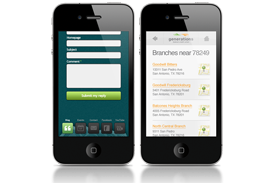Why Your Company Needs a Mobile Website
Have you ever accessed your company’s website with a smartphone or tablet? I can almost guarantee your customers have. Millions of mobile searches happen daily, and research predicts that by 2015 more people will access the Internet through their phone than their computer.
The 2011 Mobile Search Insights Study (conducted among smartphone users by Performics and ROI Research, Inc.) reveals some compelling numbers:
- 84 percent use mobile search to look for information about local retailers (hours of operation, address, contact information, etc.)
- 66 percent use mobile search while watching television
- 71 percent use mobile search to learn more about a product or service after seeing an advertisement
Despite these large numbers, some surveys indicate that as many as 70% of businesses do not have a mobile website.
Does your company advertise with billboards, company car decals, bumper stickers, or television and radio spots? You can bet customers are accessing your website from their cars or couches — it’s your job to ensure their mobile experience is as good, if not better, than when they access your site from a computer.
Your customers are going mobile; it’s time you do, too.
First steps
Before you hire someone to design and develop your mobile site (or dive into that work internally), do some research to find out what will make your audience happiest.
Establish your mobile audience’s goals
What do mobile users want to do on your mobile site? Are they stuck on a long plane ride and want to read articles or blog posts? Do they come back often to check sports scores or weather updates? Or could they be one-time visitors who wants to know your location or hours of operation?
What your audience wants to do on your mobile site should affect how your mobile site looks and functions.
Choose a development approach
There are several ways a developer can create a mobile site; the goals you set for your website will help determine which approach will work best for you. You can simplify your main website, create an adaptive or responsive layout, or create a dedicated mobile site.
Each of these has their pros and cons, and should be discussed in detail with a designer and/or developer.
Tips
Stay focused
You want your mobile website to be accessible to all, but it’s crucial to cater to the needs of your target audience (the ones who will spend the most time on the site). In trying to please everyone, you’re more likely to frustrate everyone, including your target audience.
Keep your audience’s wants and needs in mind throughout every step of design and development.
Test, test, test
Although there are many smartphone and tablet simulators you can use to see how your mobile site will appear on different devices, there is no substitute for design and function testing of your mobile site on the devices themselves.
Do you want your mobile visitors to visit a certain page, fill out a form, or interact with your site in a specific way? Test—either internally or with a focus or test group—that it’s easy for visitors to perform those tasks.
Keep testing and tweaking until you’ve optimized the user experience for your target audience.
How to get started
For a more detailed look at mobile website design ideas, strategy planning, and best practices, download the Marketer’s Mobile Blueprint to Mobile Websites. This guide has everything you need to get started with your mobile website.
MONTHLY MARKETING INSIGHTS.
Get thought-provoking and actionable insights to improve how your firm makes a connection with your customers.





LEAVE A COMMENT